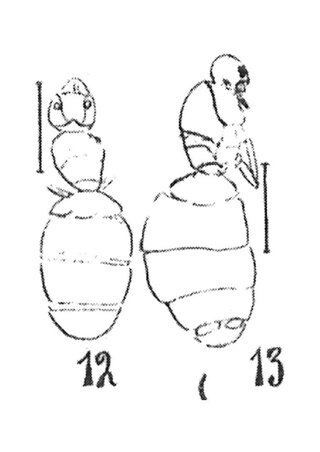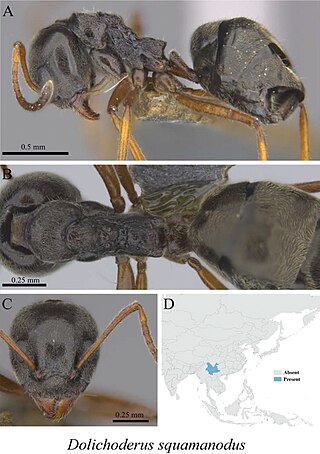
Dolichoderus is a genus of ants found worldwide.
Acanthomyrmex glabfemoralis is a species of ant that belongs to the genus Acanthomyrmex. It was described by Moffett in 1986, and is abundant in Vietnam and China.
Philidris notiala is a species of ant in the genus Philidris. Described by Zhou and Zheng in 1998, the species is endemic to China.
Dolichoderus affinis is a species of ant in the genus Dolichoderus. Described by Emery in 1889, the species is endemic to various countries of Asia.
Dolichoderus brevicornis is a species of ant in the genus Dolichoderus. Described by Dlussky in 2002, remains of the species were discovered in the Baltic Amber.

Dolichoderus bruneti is an extinct species of ant in the genus Dolichoderus. Described by Théobald in 1937, the fossils were discovered in France.
Dolichoderus dajiensis is a species of ant in the genus Dolichoderus. Described by Wang and Zheng in 2005, the species is only known from a mountainous in eastern China, and these specimens at elevations at 930 m (3051 ft).
Dolichoderus evolans is an extinct species of Miocene ant in the genus Dolichoderus. Described by Zhang in 1989, the fossilised species was discovered in China, where a possible queen has been described.

Dolichoderus feae is a species of ant in the genus Dolichoderus. Described by Emery in 1889, it is endemic to multiple countries, notably China, India, Myanmar (Burma) and Thailand.
Dolichoderus incisus is a species of ant in the genus Dolichoderus. Described by Xu in 1995, the species is endemic to China.
Dolichoderus jiaoyanshanensis is an extinct species of ant in the genus Dolichoderus. Fossils containing the species were found in China, and it was described by Hong in 1985. The ant is from Shanwang and is presumed to be a Miocene insect.

Dolichoderus kinabaluensis is a species of ant in the genus Dolichoderus. Described by Dill in 2002, the species is endemic to Borneo.
Dolichoderus luridivenosus is an extinct species of Miocene ant in the genus Dolichoderus. Described by Zhang, Sun and Zhang in 1994, the species was discovered after a fossil of a queen was found in China.
Dolichoderus moggridgei is a species of ant in the genus Dolichoderus. Described by Forel in 1886, the species is endemic to Afghanistan, China and India.
Dolichoderus pilosus is a species of ant in the genus Dolichoderus. Described by Zhou and Zheng in 1997, the species is endemic to China.
Dolichoderus rugocapitus is a species of ant in the genus Dolichoderus. Described by Zhou in 2001, the species is endemic to China.
Dolichoderus sagmanotus is a species of ant in the genus Dolichoderus. Described by Xu in 2001, the species is endemic to China.

Dolichoderus sibiricus is a species of ant in the genus Dolichoderus. Described by Emery in 1889, the species is endemic to China, North Korea, Japan, Mongolia, South Korea and Russian Federation.

Dolichoderus squamanodus is a species of ant in the genus Dolichoderus. Described by Xu in 2001, the species is endemic to China.

Dolichoderus taprobanae is a species of ant in the genus Dolichoderus. Described by Smith in 1858, the species is endemic to Asia.






